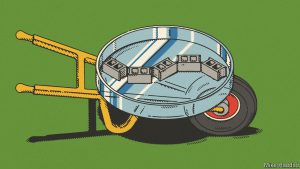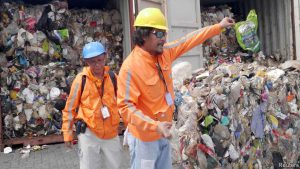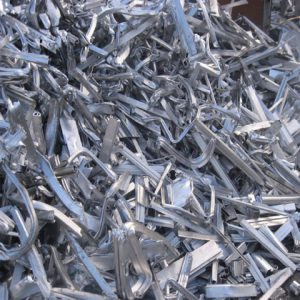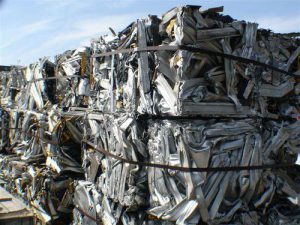Materials: It has been in use for centuries. But now, tired of being walked all over, concrete is ready for a high-tech upgrade
Sep 23rd 2006 |
THE Wizard of Menlo Park had a magic touch, but it sometimes failed him. In 1906 Thomas Edison declared that he had hit upon the “salvation of the slum dweller”—cheap concrete houses cast from single, reusable moulds. Though his Edison Portland Cement Company went on to supply concrete for New York’s Yankee Stadium and the first concrete highway, the great man’s dreams for concrete died amid complex, expensive moulds and 11 unsold demonstration houses.
A century later, materials scientists and their business partners have been picking up where Edison left off. In their search for more high-tech concrete mixtures, they have found a fast, innovative way to make cheap, durable housing for both the developing and the developed world. Other researchers have been extending Edison’s asphalt altruism in new directions, trying not only to reduce concrete’s environmental impact but also to use concrete to clean up the environment.
The recipe for concrete is simple and has been around, in one form or another, since the days of Ancient Egypt. The bulk of the material consists of aggregate—fine particles such as sand and coarse ones such as gravel or crushed stone. When water and a powdered cement are mixed in, they undergo a chemical reaction that hardens and binds the aggregates into a solid mass. To make the cement, materials such as limestone and clay are heated in large kilns to over 1,000°C. At such high temperatures, water and carbon dioxide are driven off and the limestone and clay begin to fuse to form new compounds. These are then ground into a fine powder that goes by the name of Portland cement. In America alone over 100m tonnes of the stuff are used each year.
But like good chefs, materials scientists have long known that they can tweak the basic concrete recipe to create any number of desired effects. For example, adding chemicals that encourage the trapping of tiny air bubbles makes concrete more durable, because it gives water room to expand into when it freezes, thereby avoiding tiny cracks. In the late 1990s researchers began to experiment with another additive—small amounts of electrically conductive steel or carbon fibres. Even though the fibres make up less than 1% of the concrete by volume, they have a large effect: the resulting concrete gains the ability to conduct electricity.
Electric avenues
Such concrete has a range of interesting properties. If you compress electrically conductive concrete, the fibres get slightly closer together, increasing the concrete’s electrical conductivity. So if a road is made from conductive concrete, it will be able to monitor and weigh passing traffic.
That is not all a conductive concrete road can do. Passing an electrical current through a wire causes it to heat up, just like the filament in a light bulb. An electric current will heat a road, a bridge, or a runway made of conductive concrete in just the same way. For the past three winters, the Roca Spur Bridge outside Lincoln, Nebraska, has been warming itself using an electric blanket of conductive concrete. Christopher Tuan of the University of Nebraska-Lincoln and his former student, Sherif Yehia, have been carefully monitoring the bridge. Using electrical heating, they can maintain Roca Spur at a toasty 10°C above the ambient temperature, warm enough to keep it free of snow and ice throughout the winter.
“The kilns that produce Portland cement also produce large amounts of carbon dioxide, accounting for 5-10% of global emissions.”
Although their conductive concrete is roughly four and a half times more expensive than ordinary concrete, Dr Tuan notes that this does not include the costs of accidents or corrosion due to the salt used to de-ice roads. Furthermore, using the concrete as a heater does not degrade the mechanical properties or the durability of the concrete, unlike embedding wires and sensors in traditional concrete. Conductive concrete could thus be used on heavily used bridges or airport runways. Dr Tuan is looking for people to license and commercialise his technology.
In theory, conductive concrete could also find uses in buildings. A floor of conductive concrete could reveal when someone had entered or left a room—a handy way to detect intruders or control heating and lighting. It could be used for underfloor heating, too. A building with beams of conductive concrete could detect changing loads and damage during an earthquake. Conductive concrete walls can also shield sensitive equipment from electronic eavesdroppers.
Dr Jaycee Chung of Global Contour, an engineering firm based in Rockwall, Texas, cautions that such ideas are far from being realised. Although laboratories have been refining recipes for conductive concrete for years, testing in buildings is only now getting under way. The chief task is to build systems to monitor the electrical signals coming from conductive-concrete structures. Global Contour has been developing special wireless sensors to do just that. And Dr Chung has raised half the money needed for a building in Texas to demonstrate conductive concrete’s gift for self-sensing and electromagnetic shielding.

The American army, which has funded part of Global Contour’s research, is interested in using conductive concrete in military facilities and bunkers, as well as on roads at border crossings. The Institute for Construction Research (IRC), a division of National Research Council Canada and one of the pioneers of research into conductive concrete, is also in the first stages of financing demonstration projects. The first conductive-concrete houses and offices are likely to appear in the next few years.
Casa de concrete
Self-sensing houses may appeal to the extravagant few who can afford them, but another concrete technology promises to help those who cannot. Grancrete, a company based in Mechanicsville, Virginia, has been working on a new type of ceramic, cement-like material for making quick, durable and cheap “spray-on” housing for the billion or so people in the world who lack it. Grancrete, as its invention is known, has its origins in a material invented to encapsulate nuclear waste. Its developers soon realised, though, that its real potential lay in housing people, rather than plutonium.
A small local team can be trained to mix and to apply the grancrete, which is made from a mixture of sand and a special binding agent. The team uses a hose to spray a thin coating onto a simple frame. Because grancrete binds to many surfaces, the frame can be made from wood, metal, or even polystyrene or woven matting. When it hardens, 20 minutes later, the grancrete structure is twice as strong as traditional concrete, and it is durable, fire-resistant, waterproof and non-toxic—more than can be said for most of the poor’s housing. Salt does not corrode it, so it is suitable for use in coastal areas and its insulating properties mean that it can be used both in hot and cold climates. It should also be strong enough to withstand hurricane-force winds.
Jim Paul, Grancrete’s chairman, reckons that a team of two can build a simple house in two days. All in all, he estimates that low-cost housing can be made for $12 to $15 per square foot. Grancrete opened its first full-scale production plant this summer. So far, it has performed proof-of-concept demonstrations in Venezuela and Panama, and is preparing for more in Mexico, Canada, Argentina and America.
Another new type of concrete is at an even earlier stage. Bill Price, an architecture professor at the University of Houston, has been making concrete embedded with glass or plastic mixtures and different binding agents. The resulting thin concrete panels are translucent. Dr Price has made translucent concrete into bricks and into pre-cast panels that are suitable for non-load-bearing walls. It has been exhibited at the National Building Museum in Washington, DC, at the Musée des Arts and Métiers in Paris, France, and in a pavilion near Chaumont, also in France, designed by Dr Price, his colleague Peter Zweig, and their students. So far, however, there are no firm plans for commercialisation. Dr Price’s next step is to include it in new buildings around Houston, starting with a 2.5-metre by 5-metre (8ft by 16ft) wall in a residential building.
Concrete is the second-most widely used material on earth after water. Each year, about one cubic metre of the stuff is produced for every man, woman and child on the planet. Not surprisingly, an industry of this size has a big effect on the environment. In and of itself, concrete is a durable and environmentally friendly material. Unfortunately, the kilns that produce Portland cement also produce large amounts of carbon dioxide—roughly one tonne of it for each tonne of cement. As a result, cement-making is thought to account for some 5-10% of global carbon dioxide emissions.
As concern over greenhouse-gas emissions has risen, so too has interest in materials that can replace Portland cement. Fly ash (the residue trapped in the chimneys of coal-fired power plants), blast-furnace slag (a by-product of steelmaking) and condensed silica fume (a waste-product of the semiconductor industry) have all been tried as replacement cements. Laila Raiki of the Canadian IRC thinks that the use of such supplementary cements has yet to be fully exploited. Questions remain over such things as the quality and transport costs of the waste. But the IRC wants to use such industrial by-products to make practical objects, such as roofing tiles.
Scientists have also been using concrete to get rid of unwanted material—giving waste, as it were, the proverbial concrete boots. Highly toxic materials such as the ash left over from incinerating municipal solid waste, or material dredged up when maintaining a port, are difficult and costly to dispose of. By encapsulating them in specially treated concrete, they can be dumped and serve a useful function, too. Christian Meyer, professor of civil engineering at Columbia University, has come up with treatments that allow waste glass to be used as an aggregate in concrete. Normally, glass reacts with cement, causing the concrete to swell and crack. The specially treated glass concrete is less water-absorbing, more durable, more chemically resistant and aesthetically pleasing. In addition, it encourages the recycling of glass.
Wausau Tile of Wausau, Wisconsin has licensed Dr Meyer’s technology to make decorative tiles and planters. In 2005 they used over 270 tonnes of recycled coloured glass. Sales of their recycled-glass concrete products in 2005 were 45% higher than in the previous two years; sales so far in 2006 are up another 20%, as builders show more interest in green construction techniques. “We’re still learning how to use recycling,” Dr Meyer says. As space in landfills grows short and gravel pits are mined for aggregate, he thinks alternatives like his glass will become more attractive. So concrete research continues at a furious pace. Thomas Edison would be proud.
This article appeared in the Technology Quarterly section of the print edition under the headline “Concrete possibilities”





